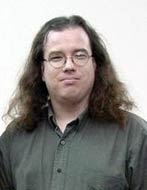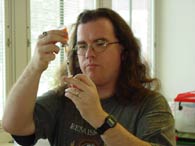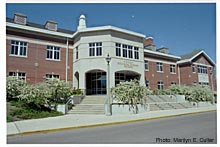Prof. Kevin Kinney on Science and Superheroes in Philadelphia Inquirer
October 13, 2003
 October 13, 2003, Greencastle, Ind. - "At DePauw University in Indiana, assistant professor Kevin Kinney looks at superheroes through the prism of biology," notes today's Philadelphia Inquirer. The story, by Tom Avril, begins, "The loner scientist in his lab. Cosmic rays and genetic mutations. Wall-crawling, underwater breathing, flying like a bird. From Aquaman to the X-Men, science is a staple of comic books. But could any of that superhero stuff really happen? BAM! ker-POW! whooosh! Darned if there aren't people who study this for a living. At least two professors lecture regularly on the subject -- one through the lens of physics, the other biology. And this month, two authors further explore the plausibility of pulp heroics in a new paperback, The Science of Superheroes."
October 13, 2003, Greencastle, Ind. - "At DePauw University in Indiana, assistant professor Kevin Kinney looks at superheroes through the prism of biology," notes today's Philadelphia Inquirer. The story, by Tom Avril, begins, "The loner scientist in his lab. Cosmic rays and genetic mutations. Wall-crawling, underwater breathing, flying like a bird. From Aquaman to the X-Men, science is a staple of comic books. But could any of that superhero stuff really happen? BAM! ker-POW! whooosh! Darned if there aren't people who study this for a living. At least two professors lecture regularly on the subject -- one through the lens of physics, the other biology. And this month, two authors further explore the plausibility of pulp heroics in a new paperback, The Science of Superheroes."
The story points out that Dr. Kinney, assistant professor of biology at DePauw, "gives a guest lecture on the subject as part of a colleague's sociology class on comic books and American culture. Also a superhero fan, Kinney nevertheless pokes holes in the science. Even assuming that Superman could lift a plane or Spider-man could scale walls and swing between skyscrapers,  it would take an impossibly large amount of energy. 'Do these guys spend all of their time carbo-loading?' Kinney asked."
it would take an impossibly large amount of energy. 'Do these guys spend all of their time carbo-loading?' Kinney asked."
The article continues, "Another of Kinney's favorites, which is also used in the book, is the 'square-cube' problem. It comes up in characters such as Giant Man, who become stronger when they get bigger. If a living creature were to grow twice as tall (and wide), he would be four times as strong, because the cross-sectional area of his muscles would quadruple. (Think of stretching a one-inch-wide square into a two-inch version. The length of a side has doubled, but the area has quadrupled.) But here's the problem: A creature twice as high would weigh eight times as much. (Now imagine a cube. If the length of a side is doubled from 1 inch to 2 inches, the volume increases from 1 cubic inch -- 1 x 1 x 1 -- to 8 cubic inches -- 2 x 2 x 2.) Eventually, it would be tough for an enlarged creature to hold up his head. That's why elephants need such thick legs, Kinney said."
Avril writes that "Kinney said the Gresh-Weinberg book is pretty good on the science, though he took issue with the  authors' prediction that genetic engineering could be used to create the X-Men. Nor are those characters likely to arise from mutation (the explanation given in the comics), Kinney said. Kinney also threw water on one theory that the book cites as possible support for Aquaman. According to something called the Aquatic Ape Theory, mankind is a branch of primates that once led an amphibious existence. That's why we have less body hair and more fat (a good underwater insulator) than apes, chimpanzees and gorillas - or so the theory goes. 'There is no evolutionary precedent for a mammal that's able to breathe water,' Kinney said. 'Which is a pity, because that's a superpower that I would love to have.'"
authors' prediction that genetic engineering could be used to create the X-Men. Nor are those characters likely to arise from mutation (the explanation given in the comics), Kinney said. Kinney also threw water on one theory that the book cites as possible support for Aquaman. According to something called the Aquatic Ape Theory, mankind is a branch of primates that once led an amphibious existence. That's why we have less body hair and more fat (a good underwater insulator) than apes, chimpanzees and gorillas - or so the theory goes. 'There is no evolutionary precedent for a mammal that's able to breathe water,' Kinney said. 'Which is a pity, because that's a superpower that I would love to have.'"
You can read the complete feature at the Inquirer's Web site by clicking here.
Source: Philadelphia Inquirer
Back